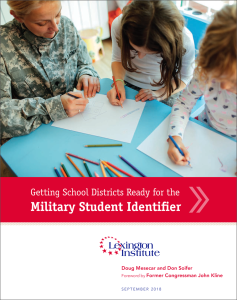The Military Student Identifier: Turning information into action

 The Military Student Identifier – introduced under the Every Student Succeeds Act, presents a powerful opportunity for states to better help our nation’s military-connected students.
The Military Student Identifier – introduced under the Every Student Succeeds Act, presents a powerful opportunity for states to better help our nation’s military-connected students.
Now that states are required to collect and report assessment data for these kids (who have a parent who is a member of the Army, Navy, Air Force, Marine Corps, and Coast Guard on active duty, including full-time National Guard duty) teachers, administrators and schools will finally have a better, clearer picture of these students’ challenges and where they might need additional supports.
However, identifying and collecting information on these students is just a starting point. In order to provide the greatest value for military families, states must use the data in a way that will demonstrably improve the education experience and learning environment for military-connected students. To make sure this happens, the data collected should be linked to programs with a proven track record of helping military-connected children and their unique educational needs.
A new report from the Lexington Institute (and completed with support from us here at the Collaborative) takes an in-depth look at how a variety of public schools are already identifying and supporting their military-connected students and using the information to ensure these students are getting the high-quality education they deserve.
This report is valuable to local education officials and administrators. By looking at the best practices and examples from across the country highlighted in the report, other states, districts, and schools can start to incorporate these ideas and best practices to their own schools to better help their own students. A matrix in the report (page 3) provides additional guidance for education leaders, framing what kinds of practices and processes can make a difference for military-connected kids.
The report is also valuable to military families. As their children transition to school districts around the country, parents can use the report and the matrix to better identify characteristics of school districts and programs that are highly successful at helping military-connected students integrate effectively and get the most out of a public education. These best practices identified by the authors can take some of the guess work out of school transitions by pointing out the types of successful programs that are designed with military students in mind.
Even when arriving at a new school that isn’t adequately serving military-connected students, families can take these examples and advocate for implementation so that their military-connected students are getting the education supports they deserve.
It’s important that everyone – parents, school administrators, and state leaders — work together to ensure that schools don’t just stop at collecting the information under the MSI requirement, and that they are turning that information and data it into actions that actually make a difference for these kids.
Click here to download the report. 
About the Collaborative for Student Success
At our core, we believe leaders at all levels have a role to play in ensuring success for K-12 students. From ensuring schools and teachers are equipped with the best materials to spotlighting the innovative and bold ways federal recovery dollars are being used to drive needed changes, the Collaborative for Student Success aims to inform and amplify policies making a difference for students and families.
To recover from the most disruptive event in the history of American public schools, states and districts are leveraging unprecedented resources to make sure classrooms are safe for learning, providing students and teachers with the high-quality instructional materials they deserve, and are rethinking how best to measure learning so supports are targeted where they’re needed most.


